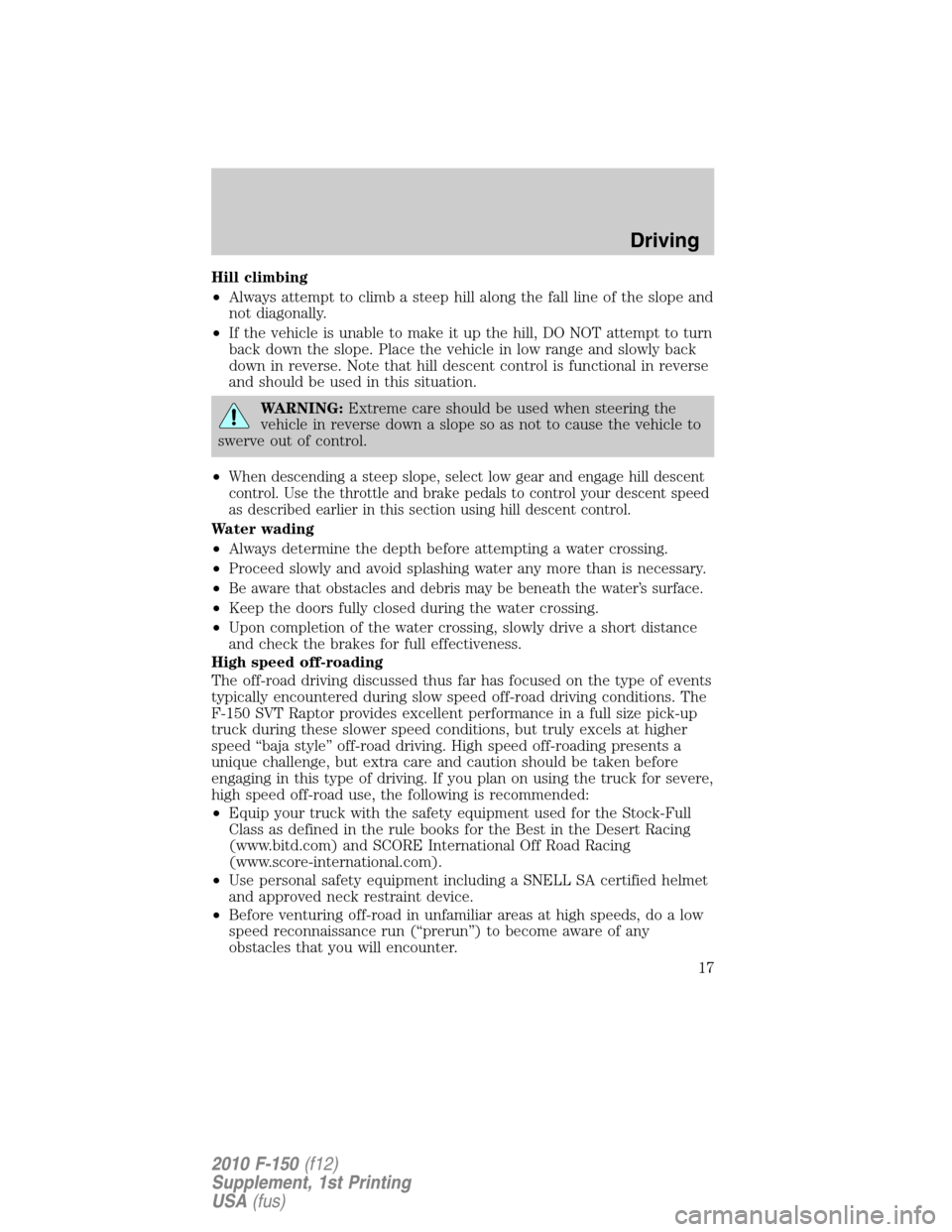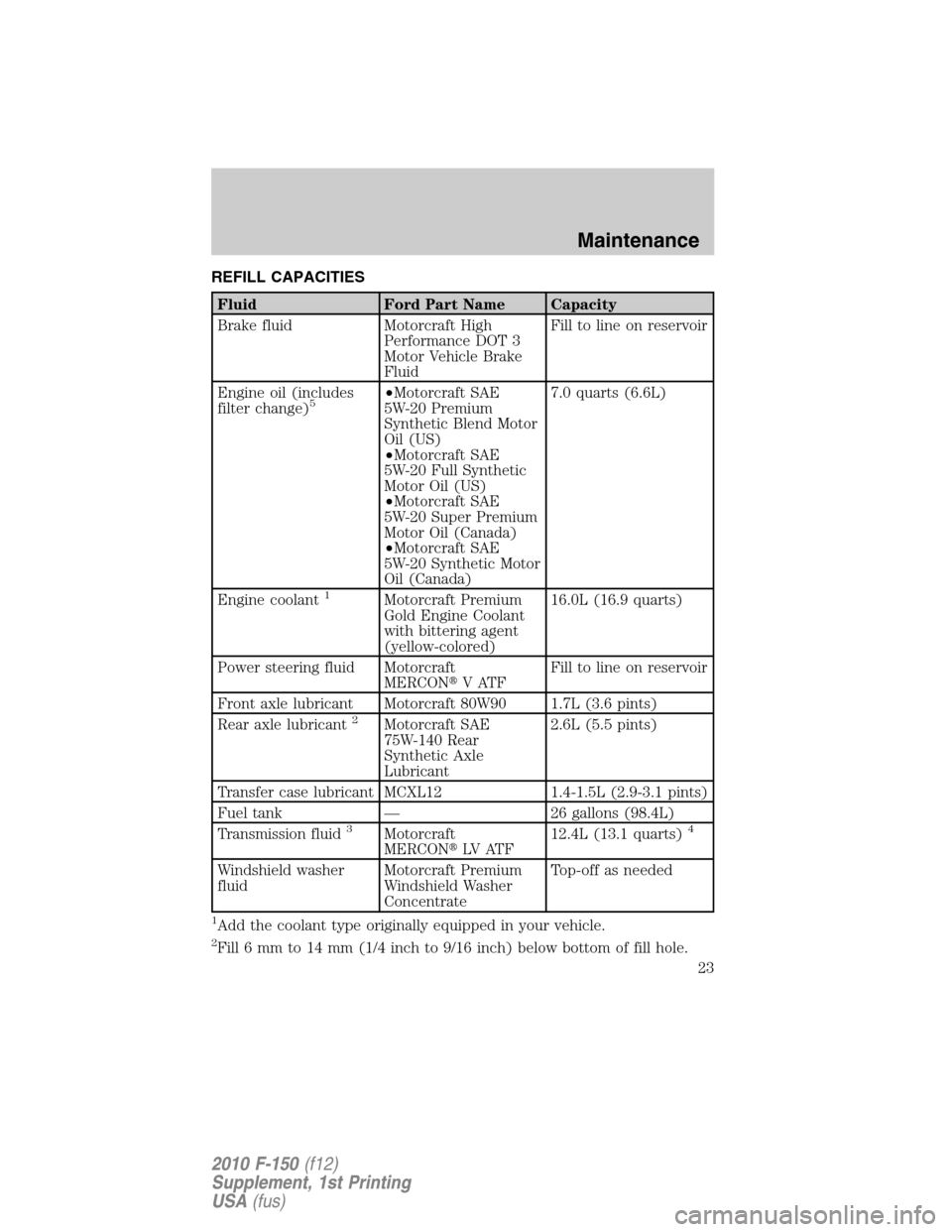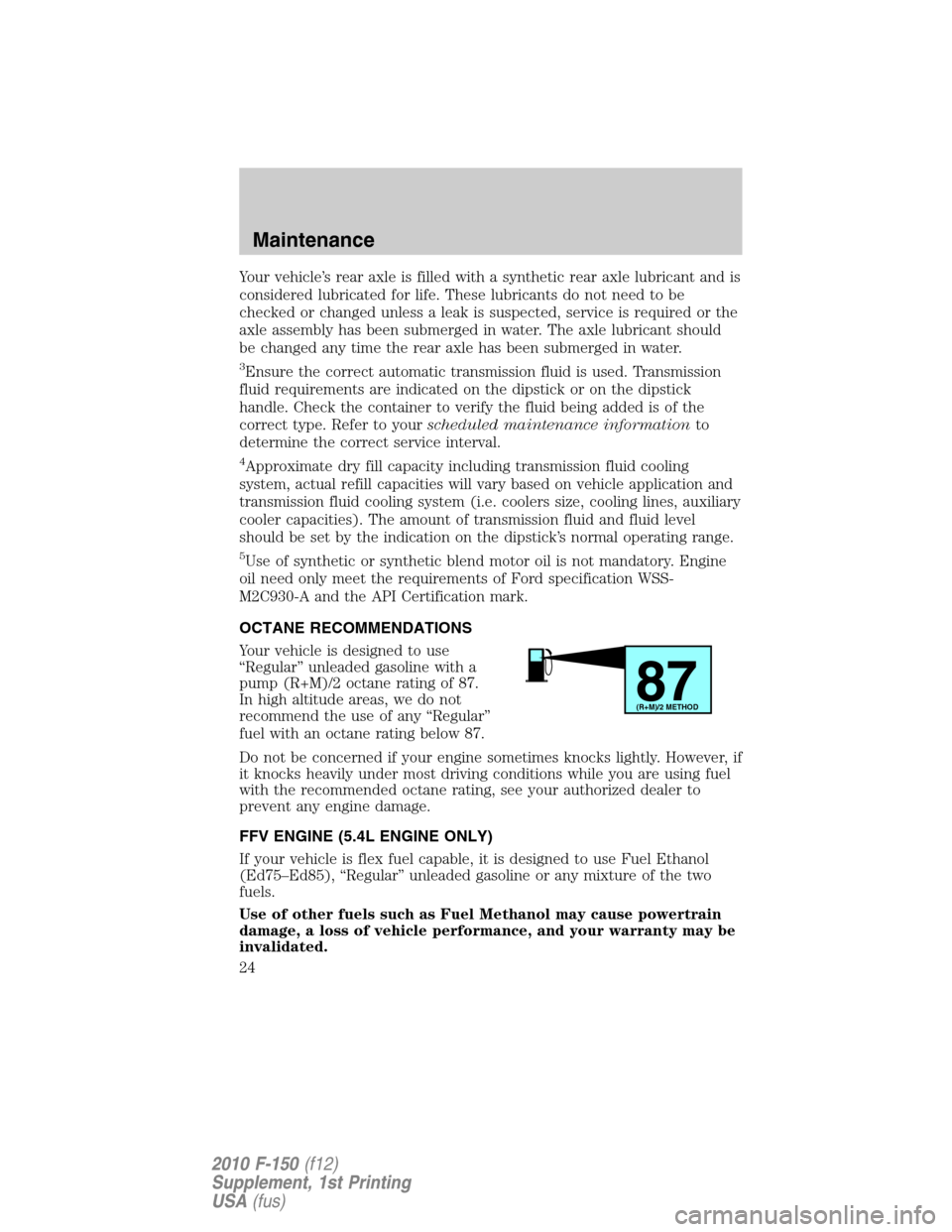Page 17 of 57

Hill climbing
•Always attempt to climb a steep hill along the fall line of the slope and
not diagonally.
•If the vehicle is unable to make it up the hill, DO NOT attempt to turn
back down the slope. Place the vehicle in low range and slowly back
down in reverse. Note that hill descent control is functional in reverse
and should be used in this situation.
WARNING:Extreme care should be used when steering the
vehicle in reverse down a slope so as not to cause the vehicle to
swerve out of control.
•
When descending a steep slope, select low gear and engage hill descent
control. Use the throttle and brake pedals to control your descent speed
as described earlier in this section using hill descent control.
Water wading
•Always determine the depth before attempting a water crossing.
•Proceed slowly and avoid splashing water any more than is necessary.
•
Be aware that obstacles and debris may be beneath the water’s surface.
•Keep the doors fully closed during the water crossing.
•Upon completion of the water crossing, slowly drive a short distance
and check the brakes for full effectiveness.
High speed off-roading
The off-road driving discussed thus far has focused on the type of events
typically encountered during slow speed off-road driving conditions. The
F-150 SVT Raptor provides excellent performance in a full size pick-up
truck during these slower speed conditions, but truly excels at higher
speed “baja style” off-road driving. High speed off-roading presents a
unique challenge, but extra care and caution should be taken before
engaging in this type of driving. If you plan on using the truck for severe,
high speed off-road use, the following is recommended:
•Equip your truck with the safety equipment used for the Stock-Full
Class as defined in the rule books for the Best in the Desert Racing
(www.bitd.com) and SCORE International Off Road Racing
(www.score-international.com).
•Use personal safety equipment including a SNELL SA certified helmet
and approved neck restraint device.
•Before venturing off-road in unfamiliar areas at high speeds, do a low
speed reconnaissance run (“prerun”) to become aware of any
obstacles that you will encounter.
Driving
17
2010 F-150(f12)
Supplement, 1st Printing
USA(fus)
Page 18 of 57

It is important that you take the time to become familiar with the
controls and dynamics of your vehicle before attempting higher speed
off-roading. Some points to consider:
•Build up speed slowly. Initially, drive at a pace which allows ample
time to fully assess the terrain around you and to understand how the
vehicle is responding to both the terrain and driver inputs. Increase
pace as comfort increases while always being mindful of how the
vehicle is responding to various events at different speeds.
•Find a wide open place to experiment with different functions on the
truck. Try a given maneuver with different vehicle settings (4H vs.
4L), (differential locked vs. unlocked), (AdvanceTrac in key-on vs.
single press vs. press and hold modes) and see how the truck
responds. Start slowly and build pace as comfort increases.
•Similarly, in a wide open space, experiment with different driving
techniques. For example, if the vehicle is tending to push straight
ahead when trying to negotiate a turn (understeering or plowing), a
light application of the brake while turning may help rotate the truck.
A wider entry to the corner or entering the corner more slowly may
help the truck turn and allow you to apply the throttle sooner after
negotiating the turn.
•Remember the phrase�smooth is fast�. This refers to your steering,
throttle, and brake movements. Smooth decisive movements will yield
improved results while helping to increase safety.
•As speed increases, it is wise look farther ahead of the vehicle so that
there is time to react to oncoming obstacles. Remember that in many
off-road environments, obstacles will be hard to see until they are
relatively near. A good strategy is to alternate between looking far
ahead and up closer to the front of the vehicle as you’re driving.
•Also remember to�drive what you can see�. This refers to not driving
faster than you are able to negotiate unforeseen upcoming obstacles.
This could refer to obstacles over a brow, in a ravine, in brush, in
dusty conditions, and in the darkness among others.
•If you are driving in a dusty area. Be sure to leave ample distance
between you and any other vehicles to ensure adequate vision.
•Always remember that you may not be the only one in a particular
recreational area, always be cognizant of others in your area. This is
especially true of motorcycles and ATV’s which may be more difficult
to spot than a full-sized vehicle.
•If driving in desert conditions, it is advised that you always drive with
your headlights on to help other drivers more easily see you.
Driving
18
2010 F-150(f12)
Supplement, 1st Printing
USA(fus)
Page 19 of 57

•While driving in desert conditions, the midpoint of the day is the most
difficult time to see many of the small ridges and dips due to�flat
shadows�from the sun being at its highest point. Extreme care should
be taken at these times to not inadvertently run into these obstacles.
•It is highly encouraged that you switch to off-road mode and perform
an�AdvanceTrac single press�to ensure improved off-road braking
performance under these conditions. Be sure to disengage the
�off-road mode�and switch back to�AdvanceTrac key-on mode�before
performing any street driving. Please see the Off-road mode section of
this supplement for more details.
After off-road driving
It is important to complete a full vehicle inspection after off-road driving.
Some items to check include:
•Ensure that tires are inflated to proper tire pressure as indicated on
the tire placard.
•Check the wheels and undercarriage for built up mud or debris which
can cause vehicle vibration.
•Ensure that the grille and radiator are clear of any obstructions that
may effect cooling.
•Ensure that the brakes are in proper working order and free of any
mud, stones etc., which can become trapped around the brake rotor,
backing plate and caliper.
•Check that the air filter is clean and dry.
•Inspect for torn or punctured boots on ball joints, half shafts, steering
gears.
•Inspect exhaust system for damage or looseness.
•Inspect undercarriage fasteners. If any are loose or damaged, tighten
or replace ensuring that the proper torque specification is used.
•Inspect the tires for any cuts in the tread or sidewall area. Also
inspect the sidewall for any bulge indicating damage to the tire.
•Inspect the wheels for dents, cracks, or other damage.
Driving
19
2010 F-150(f12)
Supplement, 1st Printing
USA(fus)
Page 20 of 57
WRECKER TOWING
If you need to have your vehicle towed, contact your roadside assistance
center or a professional towing service.
It is required that your vehicle be towed with flatbed equipment. When
towing with a flatbed, 4x4 blocks must be used when loading/unloading
your vehicle. Do not tow with a slingbelt. Ford Motor Company has not
approved a slingbelt towing procedure.
If the vehicle is towed by other means or incorrectly, vehicle
damage may occur.
Roadside Emergencies
20
2010 F-150(f12)
Supplement, 1st Printing
USA(fus)
Page 21 of 57
WASHING YOUR F-150 SVT RAPTOR
Do not drive your vehicle through an automated, commercial car
wash due to the vehicle’s tire width and track. Wash your vehicle
by hand, or by using a touchless commercial wash with no
mechanical tracks on the floor. Do not use a commercial or high
pressure wand on the bed side graphic surface or graphics edges.
Cleaning
21
2010 F-150(f12)
Supplement, 1st Printing
USA(fus)
Page 22 of 57
MOTORCRAFT PART NUMBERS
Component 5.4L Triton V8 engine 6.2L V8 engine
Air filter element FA-1883 FA-1883
Battery BTX-59 or BTX-65-650
1BTX-59 or
BTX-65-6501
Oil filter FL-820S FL-820S
Spark plugs22
1
Heavy-duty battery, if equipped
2For spark plug replacement, see your authorized dealer. Refer to
scheduled maintenance informationfor the appropriate intervals for
changing the spark plugs.
Replace the spark plugs with ones that meet Ford material and
design specifications for your vehicle, such as Motorcraft or
equivalent replacement parts. The customer warranty may be
void for any damage to the engine if such spark plugs are not
used.
Maintenance
22
2010 F-150(f12)
Supplement, 1st Printing
USA(fus)
Page 23 of 57

REFILL CAPACITIES
Fluid Ford Part Name Capacity
Brake fluid Motorcraft High
Performance DOT 3
Motor Vehicle Brake
FluidFill to line on reservoir
Engine oil (includes
filter change)
5•Motorcraft SAE
5W-20 Premium
Synthetic Blend Motor
Oil (US)
•Motorcraft SAE
5W-20 Full Synthetic
Motor Oil (US)
•Motorcraft SAE
5W-20 Super Premium
Motor Oil (Canada)
•Motorcraft SAE
5W-20 Synthetic Motor
Oil (Canada)7.0 quarts (6.6L)
Engine coolant
1Motorcraft Premium
Gold Engine Coolant
with bittering agent
(yellow-colored)16.0L (16.9 quarts)
Power steering fluid Motorcraft
MERCON�VATFFill to line on reservoir
Front axle lubricant Motorcraft 80W90 1.7L (3.6 pints)
Rear axle lubricant
2Motorcraft SAE
75W-140 Rear
Synthetic Axle
Lubricant2.6L (5.5 pints)
Transfer case lubricant MCXL12 1.4-1.5L (2.9-3.1 pints)
Fuel tank — 26 gallons (98.4L)
Transmission fluid
3Motorcraft
MERCON�LV AT F12.4L (13.1 quarts)4
Windshield washer
fluidMotorcraft Premium
Windshield Washer
ConcentrateTop-off as needed
1Add the coolant type originally equipped in your vehicle.
2Fill 6 mm to 14 mm (1/4 inch to 9/16 inch) below bottom of fill hole.
Maintenance
23
2010 F-150(f12)
Supplement, 1st Printing
USA(fus)
Page 24 of 57

Your vehicle’s rear axle is filled with a synthetic rear axle lubricant and is
considered lubricated for life. These lubricants do not need to be
checked or changed unless a leak is suspected, service is required or the
axle assembly has been submerged in water. The axle lubricant should
be changed any time the rear axle has been submerged in water.
3Ensure the correct automatic transmission fluid is used. Transmission
fluid requirements are indicated on the dipstick or on the dipstick
handle. Check the container to verify the fluid being added is of the
correct type. Refer to yourscheduled maintenance informationto
determine the correct service interval.
4Approximate dry fill capacity including transmission fluid cooling
system, actual refill capacities will vary based on vehicle application and
transmission fluid cooling system (i.e. coolers size, cooling lines, auxiliary
cooler capacities). The amount of transmission fluid and fluid level
should be set by the indication on the dipstick’s normal operating range.
5Use of synthetic or synthetic blend motor oil is not mandatory. Engine
oil need only meet the requirements of Ford specification WSS-
M2C930-A and the API Certification mark.
OCTANE RECOMMENDATIONS
Your vehicle is designed to use
“Regular” unleaded gasoline with a
pump (R+M)/2 octane rating of 87.
In high altitude areas, we do not
recommend the use of any “Regular”
fuel with an octane rating below 87.
Do not be concerned if your engine sometimes knocks lightly. However, if
it knocks heavily under most driving conditions while you are using fuel
with the recommended octane rating, see your authorized dealer to
prevent any engine damage.
FFV ENGINE (5.4L ENGINE ONLY)
If your vehicle is flex fuel capable, it is designed to use Fuel Ethanol
(Ed75–Ed85), “Regular” unleaded gasoline or any mixture of the two
fuels.
Use of other fuels such as Fuel Methanol may cause powertrain
damage, a loss of vehicle performance, and your warranty may be
invalidated.
87(R+M)/2 METHOD
Maintenance
24
2010 F-150(f12)
Supplement, 1st Printing
USA(fus)